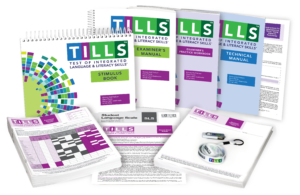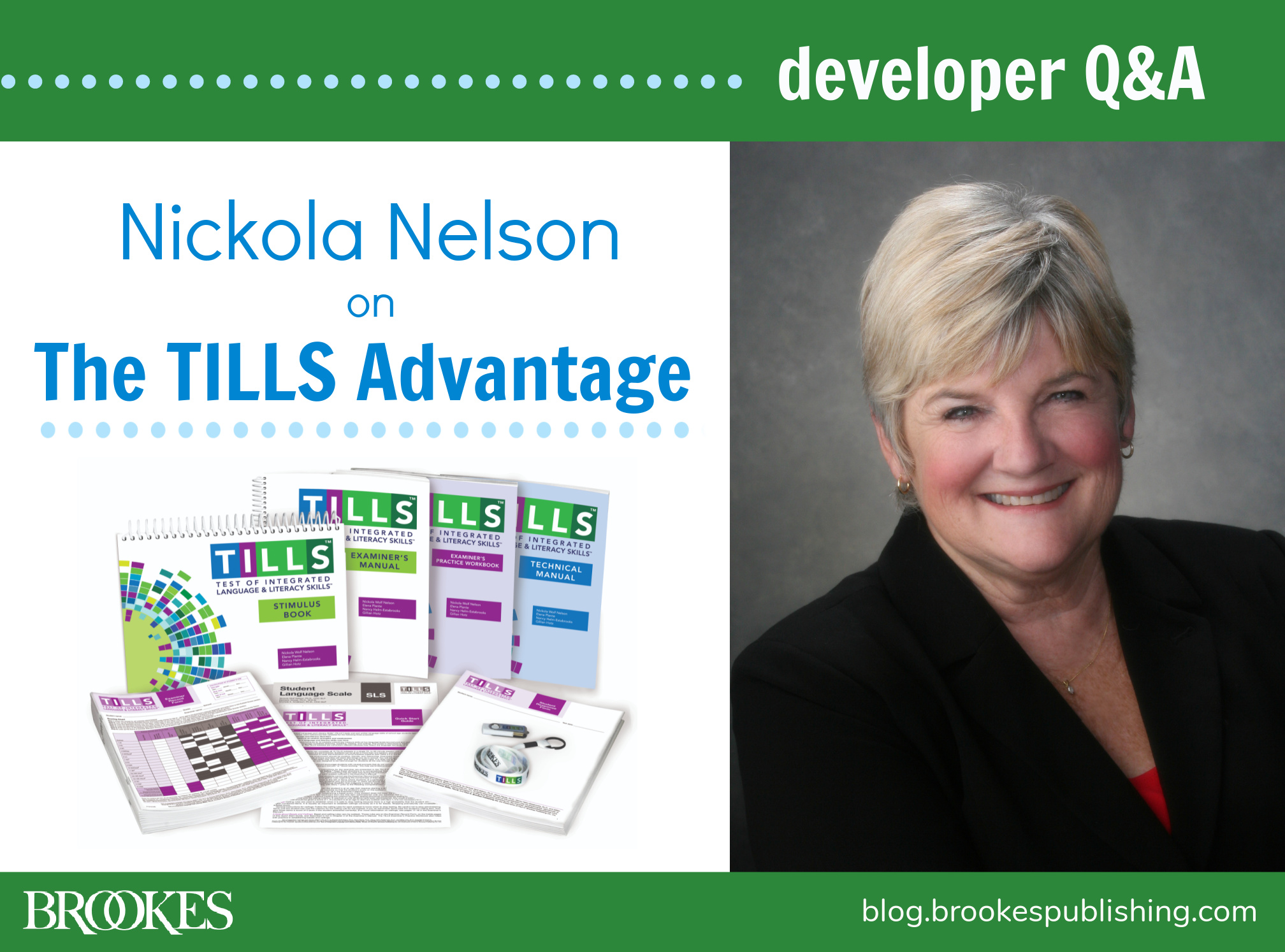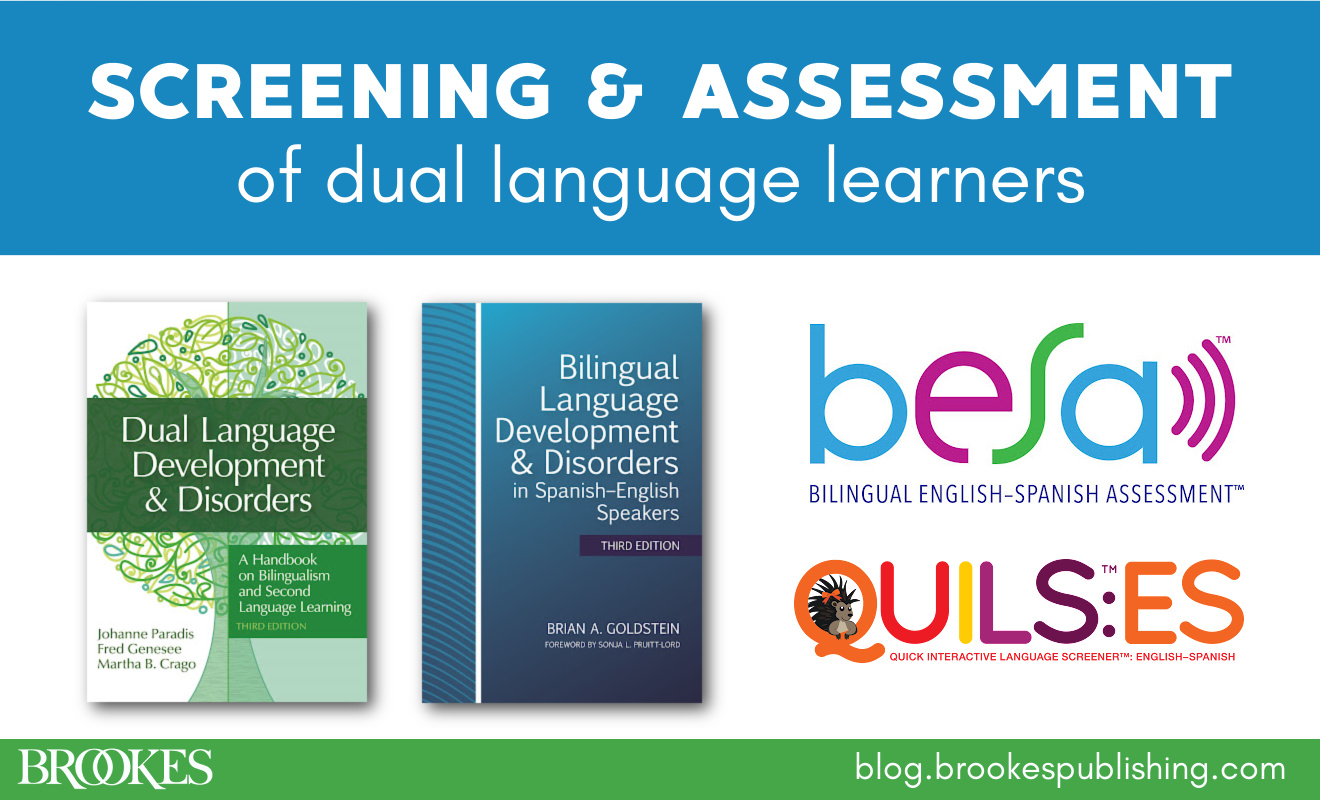If you’re an SLP, special educator, or reading specialist, you might already use the Test of Integrated Language & Literacy Skills™ (TILLS™). Developed by a team of highly respected experts—Nickola Nelson, Elena Plante, Nancy Helm-Estabrooks, and Gillian Hotz—TILLS is a groundbreaking assessment that tests oral and written language skills in students ages 6–18 years.
 Whether you’re a TILLS novice or an established user with questions, today’s FAQ will be a helpful source of information about this assessment tool. (Have another question about TILLS? Let us know in the comments below!)
Whether you’re a TILLS novice or an established user with questions, today’s FAQ will be a helpful source of information about this assessment tool. (Have another question about TILLS? Let us know in the comments below!)
What are the purposes of TILLS?
Reliable, valid, and comprehensive, TILLS is the one test kit you need to identify and diagnose language and literacy disorders (including dyslexia and developmental language disorder), document patterns of relative strengths and weaknesses, and track changes in language and literacy skills over time.
Does TILLS measure expressive and receptive language?
Yes, TILLS measures expressive and receptive language, but no, it does not give you separate scores that are broken down in this way. Research has shown that there is no effective way to measure receptive and expressive language separately from each other. Any language assessment task requires at least some integration of language input and output, so to offer separate scores would be artificial. Consistent with this design, the DSM-5 no longer has a category for receptive and expressive disorders.
Why should I test an older student when I already know they have a disability?
Simply knowing that a student has a disability doesn’t provide clinicians or educational teams with all the information they need to provide effective interventions. With TILLS, educators and clinicians will get a complete profile of a student’s oral and written language skills, allowing them to focus interventions on the area(s) with which the student is struggling. Older students who are transitioning out of high school may also need updated testing to document a disability for workplace or higher education accommodations under the Americans with Disabilities Act (ADA).
Can TILLS be used with children who have special needs? What modifications am I allowed to use and do you have any tips for testing students with special needs?
Students from three special populations were included in the TILLS standardization trials. These students were enrolled in the studies because they had been identified previously as having one of the following diagnoses: autism spectrum disorder, Deaf or hard of hearing, or intellectual disability (also called cognitive impairment). TILLS can provide information about the language-literacy and memory skills of students with any of these diagnoses; however, it is inappropriate to administer TILLS to any student with intellectual disability or autism who is functioning below a developmental age of approximately 6 years. In addition, it is inappropriate to test Deaf or hard-of-hearing students with TILLS unless they have cochlear implants or properly fitted hearing aids or other hearing devices and have been learning language primarily through auditory-oral pathways rather than through sign language. Modifications and tips for administering TILLS to students with special needs can be found in the TILLS Examiner’s Manual.
Is it recommended that you always give a student the entire assessment each time, or can you just give subtests that are areas of concern?
TILLS was developed so that you may administer single subtests or combinations of them as well as the entire test. However, we recommend administration of all TILLS subtests in order to develop a comprehensive profile of a student’s relative strengths and weaknesses. You should be able to administer all 15 subtests to most students in one 70- to 90-minute session or two 45-minute sessions. If shorter sessions are required, all sessions should be completed within a time span of no more than 4 weeks. For tracking change in a particular skill area, you may wish to administer only those subtests that relate to that skill area. Ten of the fifteen subtests that make up TILLS can be given as stand-alone measures. Another five must be given after another related subtest.
Do you have a screener or questionnaire to give to teachers or parents? Or some short test that a professional can do quickly to see if further literacy assessment is also warranted?
Included with TILLS is a Student Language Scale (SLS), which can be completed by parents, teachers, and students to show each party’s perspective on how the student is performing on academic tasks as compared to their same age peers. It’s a simple one-page questionnaire that helps identify students’ strengths and weaknesses in language and literacy skills and other non-language areas (though it’s not a pragmatics checklist). The SLS is to be used with TILLS, and is also recommended for use as a stand-alone tool to gather valuable information about a student, or for use with other assessments of student performance and potential. You could also start by giving the Identification Core subtests on the TILLS to decide whether it you should give the entire TILLS battery.
Is this an assessment that can be used more than once a year (i.e., can it be used for progress monitoring)?
TILLS can be administered to the same student as frequently as two times per year (i.e., after a minimum of 6 months since the first administration). TILLS is not appropriate for progress monitoring on a weekly or monthly basis. Curriculum-based measures are better suited for this purpose.
I have a student who speaks another language. Is it okay for me to translate the items into the student’s language?
Translation of TILLS test items into another language is not permitted. Translating items into another language creates differences in item characteristics that can shift the relative difficulty of the items dramatically and can undermine their validity and reliability. It also makes comparisons to normative data inappropriate. TILLS was not designed to be used with students who do not speak English as their primary language.
TILLS may be used with students who speak English natively and also speak or are learning a second language (sometimes called “simultaneous English language learners”). However, it has not been standardized for students who speak another language natively and are in the process of learning English as a second language. TILLS should not be used for making diagnostic decisions about the language status of such learners (sometimes called “sequential English language learners”).
Why is it important to consider phonological language abilities in a comprehensive assessment of language and literacy?
Students who demonstrate difficulties with phonological aspects of oral language at the sound/word level in Nonword Repetition, Nonword Spelling, and Nonword Reading. A key difference in these subtests is that the written language nonword tasks require the ability to relate letter sequences to phonological sequences, going from letters to sounds in the case of Nonword Reading and sounds to letters in the case of Nonword Spelling. When students exhibit similar problems when attempting to repeat, read, and spell nonword items, it may signal a need for intervention aimed at helping them become more aware of the phonological elements that are represented by alphabetic sequences and patterns in print.
When students have strengths in reading compared to spoken repetition and spelling, as students do who are Deaf or hard-of-hearing or who have marked oral language deficits, it may be helpful to teach them to draw on their stronger abilities to perceive and remember print to help them perceive and remember speech sounds in words. Conversely, if students have strengths in the oral modality compared to processing orthographic patterns in print, as students with dyslexia do, clinicians might emphasize speech sound awareness to learn associations with print in reading decoding or spelling unfamiliar words.
Can TILLS items be used for intervention?
The answer to this question is an unqualified “no.” The format and materials of testing should always be independent of the format and materials used for intervention. Using test items, test format, or test materials outside of the formal testing context is strictly forbidden. Scores on the TILLS subtests are designed to point to skill areas to address in intervention, not to provide the specific methods, items, or materials for intervention. (The TILLS Examiner’s Manual, however, does provide case studies that illustrate the progression from TILLS test scores to curricular considerations.)
When assessing children suspected of having a language disability, would you use TILLS plus another general language measure, or will TILLS assess all that I need to know for a suspected language disability?
TILLS alone can likely meet your diagnostic needs in a manner that will be satisfying to parents and therefore, may be less likely to trigger controversy and subsequent independent evaluations or hearings. You can always give other tests too if you want to follow up on a particular hypothesis, but TILLS is validated to identify language and literacy disorders using the Identification Core subtests (3-5 depending on the student’s age), and scientific evidence is provided showing acceptable sensitivity and specificity at each age level. Additional measures are not needed to give a comprehensive picture of the student’s language and literacy abilities.
Want to learn more about TILLS? Visit the TILLS website for an introductory webinar, FAQs, a 28-page sampler, case stories, an extended FAQ, and much more.





Write a Comment
Your email address will not be published. Required fields are marked *
Post a Comment